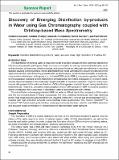Por favor, use este identificador para citar o enlazar a este item:
http://hdl.handle.net/10261/201291COMPARTIR / EXPORTAR:
 SHARE
BASE SHARE
BASE
|
|
| Visualizar otros formatos: MARC | Dublin Core | RDF | ORE | MODS | METS | DIDL | DATACITE | |

| Título: | Discovery of Emerging Disinfection by-products in Water using Gas Chromatography coupled with Orbitrap-based Mass Spectrometry |
Autor: | Cojocariu, Cristian; Postigo, Cristina CSIC ORCID ; Richardson, Susan D.; Barceló, Damià CSIC ORCID; Silcock, Paul | Palabras clave: | Water Iodinated disinfection by-products Accurate mass High resolution Q Exactive GC |
Fecha de publicación: | 2019 | Citación: | Brazilian Journal of Analytical Chemistry 6 (22): 98-105 (2019) | Resumen: | The disinfection of drinking water is required in order to protect consumers from potential waterborne infectious and parasitic pathogens. Water is commonly treated by adding chemical disinfectants, such as free chlorine, chloramines, chlorine dioxide, and ozone. However, although very effective in removing disease-causing microorganisms, these disinfectants can react with naturally occurring materials in the water and can form disinfection by-products (DBPs) which can be harmful to human health. In particular, compounds containing an iodo-group, i.e., iodinated DBPs (iodo-DBPs), may pose a greater health risk for the population exposed to them than their brominated and chlorinated analogues [1]. In recent years, several chemical classes of low molecular weight iodo-DBPs have been reported; however, many more may be still present in the unknown fraction (~50%) of halogenated material formed during disinfection treatments [2]. Therefore, complete characterization of iodo-DBPs present in DBP mixtures is crucial to further investigate their occurrence in disinfected waters and potential toxicity effects. The identification of emerging iodinated DBPs in water is difficult due to the complexity of this matrix and the low concentrations of these compounds. For this, analytical techniques with high resolving power, high mass accuracy and sensitivity are required. In this work, a novel gas chromatography (GC), coupled with high-resolution accurate mass Orbitrap mass spectrometer (the Thermo Scientific™ Q Exactive™ GC hybrid quadrupole-Orbitrap mass spectrometer), has been used for iodo-DBPs detection and accurate mass identification in chlorinated and chloraminated water samples | Versión del editor: | http://dx.doi.org/10.30744/brjac.2179-3425 http://www.brjac.com.br/artigos/2019-V6-N22/BrJAC-2019-V6-N22-pp-98-105.pdf https://issuu.com/brazilianjournal/docs/brjac-2019-n22?fr=sMDVhYjIwODQ4Nw |
URI: | http://hdl.handle.net/10261/201291 | ISSN: | 2179-3433 |
| Aparece en las colecciones: | (IDAEA) Artículos |
Ficheros en este ítem:
| Fichero | Descripción | Tamaño | Formato | |
|---|---|---|---|---|
| Discovery of Emerging Disinfection by-products.pdf | Artículo principal | 864,65 kB | Adobe PDF |  Visualizar/Abrir |
CORE Recommender
Page view(s)
195
checked on 24-abr-2024
Download(s)
194
checked on 24-abr-2024
Google ScholarTM
Check
NOTA: Los ítems de Digital.CSIC están protegidos por copyright, con todos los derechos reservados, a menos que se indique lo contrario.


